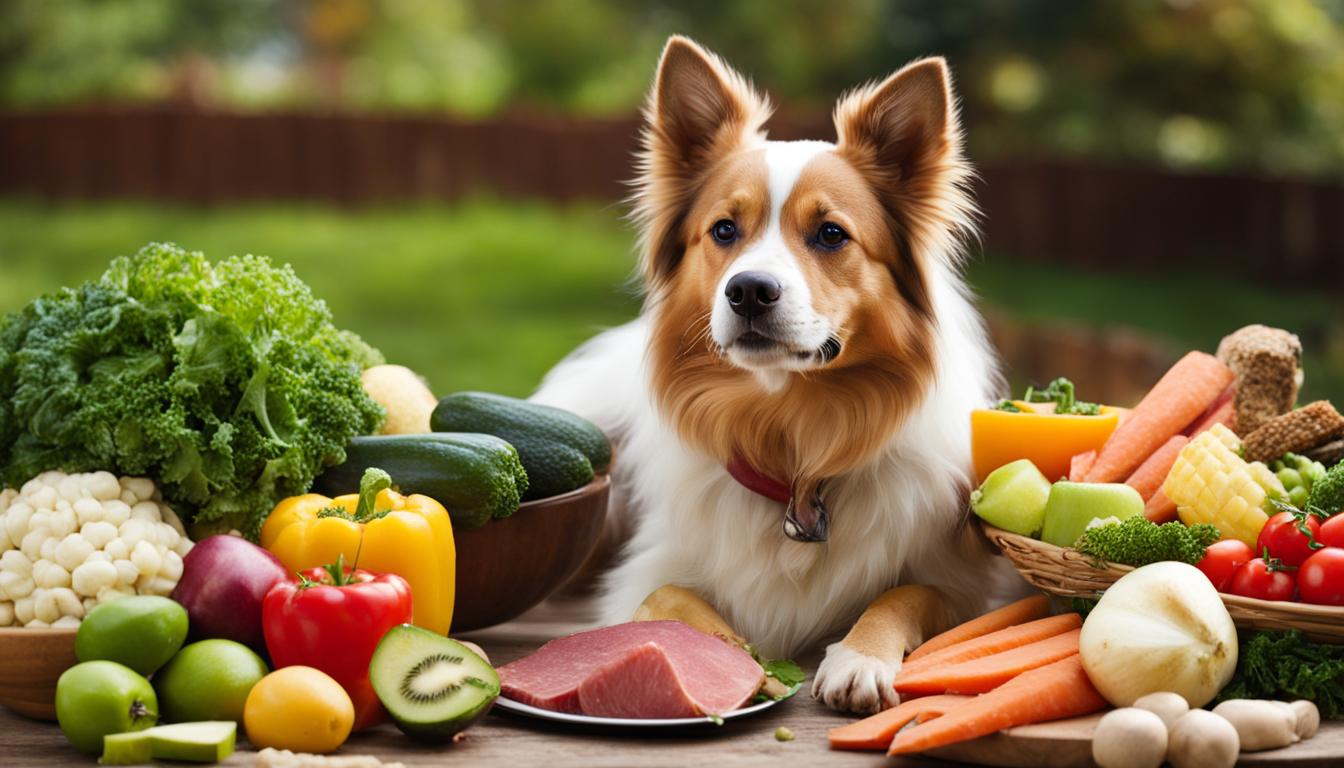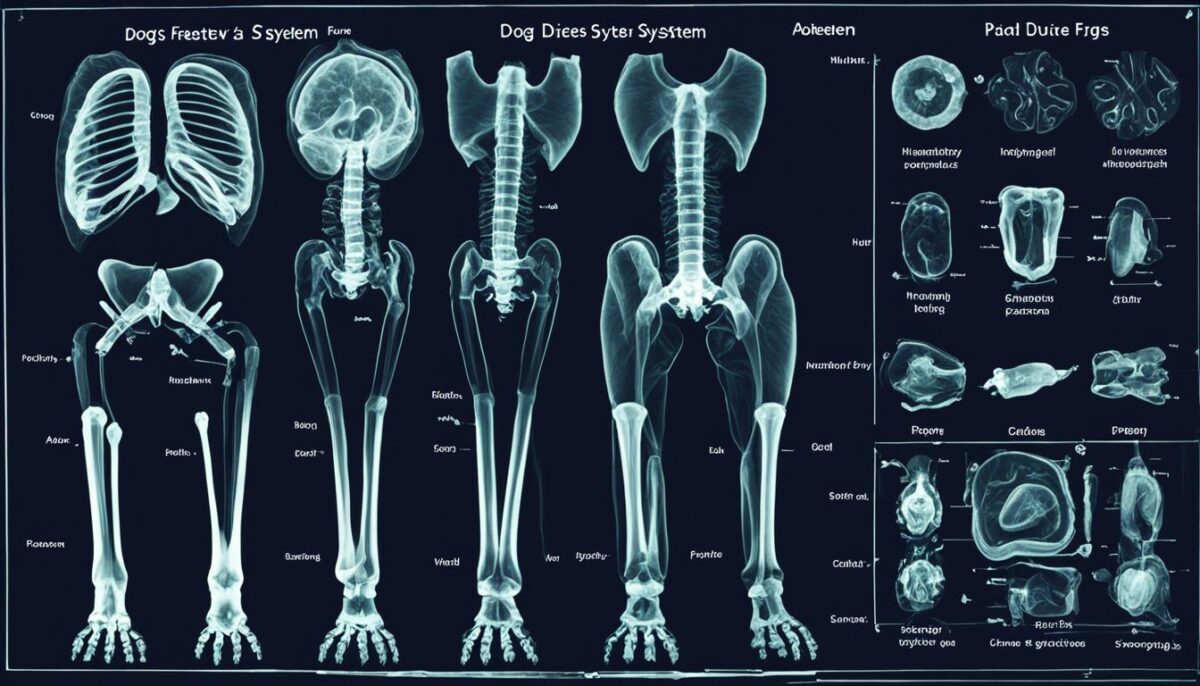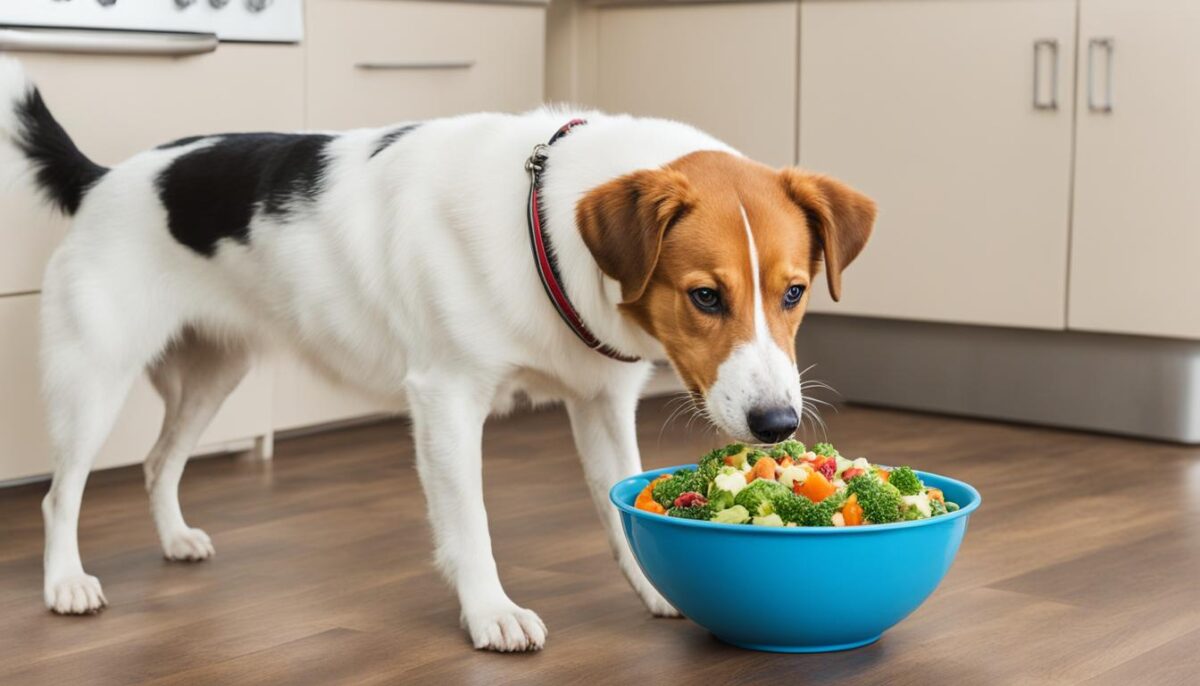Is your dog looking a bit thin? Can you see their bones too easily? If that’s the case, your furry friend might need some extra help with their diet. Keeping an eye on your dog’s body and how they act is a good first step. A healthy coat and good energy are signs your dog is doing well. But if they seem tired and their coat isn’t shiny, it might be time for a check-up.
It’s important to make sure they don’t have any health problems. Sometimes, not eating right or feeling sick can make them lose weight too. If everything’s okay, you might just need to change their food. Foods full of good fats and proteins can help your dog get back to a healthy weight. And with the right changes, you might see them looking better in just a few weeks!
Change their diet slowly over about 10 to 14 days to keep their tummy happy. And think about breaking up their meals. Giving them food more times a day can help them put on weight in a good way.
Key Takeaways
- Check if bones are showing to see if your dog’s underweight.
- Bring them to a vet if they’re losing weight for no clear reason.
- Look for foods with more protein and fat to help them get bigger.
- Switch to the new food bit by bit to keep their stomachs from getting upset.
- Dividing meals throughout the day might help with healthy weight gain.
Understanding Underweight Dogs: Recognizing the Signs
If you have a furry friend who seems to be lighter than they should be, you might be looking at signs of an underweight dog. It’s important you know what to look for. This way, you can help ensure your pet stays happy and healthy. Let’s learn about the signs that indicate your dog could be underweight.
Visual Signs: Ribs and Bone Prominence
One of the easiest ways to tell if a dog is too skinny is by looking for visible ribs, hips, and other bones. When a dog doesn’t have enough fat, you can see and sometimes feel these bones easily. This is one of the clear signs of malnutrition in dogs. Remember, it’s normal to feel a dog’s ribs, but you shouldn’t be able to see them from a distance.
Behavior Changes: Lethargy and Dull Coat
Has your dog lost its usual energy? If they are often tired or don’t want to play like they used to, this could be a signal of poor canine health indicators. Also, a shiny coat is a sign of good dog health. If your pet’s coat has become dull and doesn’t shine, it might mean they are not getting the right nutrition.
Medical Check-Up: Ruling Out Health Issues
When you see these changes in your dog, take them for a medical check-up. A vet can find out if there’s a health issue causing the weight loss. Problems with the teeth can make it hurt for your dog to eat, and some diseases can stop their body from using the food they eat. So, visiting the vet can help you identify an underweight pet and fix any problems.
| Symptom | What It Might Mean | What You Can Do |
|---|---|---|
| Visible ribs, hips, and spine | Not enough fat or muscle | Schedule vet appointment and review diet |
| Lack of energy | Possible malnutrition or illness | Consult vet and ensure proper feeding |
| Dull, lifeless coat | Poor nutrition | Look into a more nutritious diet |
Recognizing these signs early can help you take the right steps to improve your dog’s weight and overall health. Always consult with a vet if you’re unsure about your pet’s condition.
Reasons Your Dog Isn’t Gaining Weight
Have you noticed your furry friend isn’t putting on weight? It can be worrying when your dog doesn’t gain weight like they should. There are many reasons why this might happen. Your dog could be a picky eater, or maybe there are stressors in dogs that we need to think about. Sometimes, a dog not gaining weight could mean canine illnesses are present. Also, as dogs get older, age-related weight loss is a concern.
If your dog is a picky eater, it could help to give them yummier options. Adding wet food or tasty toppers might make their meals more appealing. It’s like when we get to put our favorite topping on ice cream—it just makes it better!
Stress can also stop dogs from gaining weight. Imagine how hard it would be to eat when you’re worried or scared. Dogs feel that way too. If your dog seems stressed, look around to see what might be causing it and try to make them feel safe and happy.
Just like people, dogs can get sick. If your dog loses weight quickly, it’s time to see the vet. They can find out if an illness is making it hard for your pooch to stay at a healthy weight.
Older dogs often have their own set of problems. Their teeth might not be as good as they used to be, which can make eating tough. They need softer food that’s easy to chew. The right food for older dogs helps them keep on weight, even if their teeth hurt.
And if you’ve just brought a new dog home from a shelter or another home, they might need time to adjust. They might not eat a lot at first. Watching what and how much they eat can help you figure out the best way to feed them.
It can be a little tricky to understand why your dog isn’t gaining weight, but here’s a simple list of things to think about:
- Is their food yummy enough?
- Do they have a calm, happy place to eat?
- Could they be sick and need a vet?
- Are they old and need special food for seniors?
- Are they new to your home and still getting used to things?
Let’s remember, every dog is unique. What works for one might not work for another. It’s important to find out what makes your dog happy and healthy!
Here’s a table to help us see why dogs might not gain weight. It’s good to go through it and match what you see with your dog so you can understand better.
| Reason | What You Can Do |
|---|---|
| Fussy Eaters | Try different food flavors and textures |
| Stressful Environment | Create a quiet, calm space for eating |
| Possible Illness | Visit the vet for a check-up |
| Getting Older | Switch to foods designed for senior dogs |
| New Home Adjustment | Give them time and observe their habits |
Remember, with a little patience and care, you can help your dog get to a healthy weight. The key is to understand what they need and to give them lots of love!
How Can I Get My Dog to Gain Weight: Tips and Tricks
Helping your furry friend put on weight can be a tail-wagging success with the right diet for underweight dogs. High nutrient foods, a consistent feeding schedule, and a smart weight gain strategy play a big part. Let’s fetch some tips and tricks to plump up your pup the healthy way!
Diet Improvements: High Fat and Protein
When it comes to boosting your dog’s weight, it’s not just about more food—it’s about the right food. Look for meals packed with fats and proteins to help your doggo grow strong and healthy. Foods like lean meats, eggs, and even special doggy diets designed for weight gain can be your best pals.
Introducing New Foods Gradually
Changing your dog’s menu? Do it slow to keep their tummy happy. Mix a little bit of the new high-calorie yummies with their usual kibble, then gradually give them more over time. It’s like sneaking veggies into a kid’s dinner but way more delicious for your dog!
Meal Scheduling for Optimal Weight Gain
Did you know that when you feed your pup can help them bulk up? Try giving a small meal in the morning and a bigger one at night. Think of it as breakfast for energy, and dinner as fuel for growing while sleeping. Stick to this plan, watch your dog enjoy, and see them get chubbier.
Now, let’s peek at a meal plan made for a champ:
| Meal | Food Type | Amount | Feeding Time |
|---|---|---|---|
| Breakfast | High-protein kibble | 1/4 portion | Morning |
| Lunch | Chicken or fish | 1/4 portion | Noon |
| Dinner | Weight-gain wet food | 1/2 portion | Evening |
Following this plan will make sure your dog’s tail keeps wagging, and their weight gets back on track! Remember, the best treats are given with love and care. So let’s get your pup feeling paw-some again!
Designing Your Dog’s Diet for Safe Weight Gain
When your furry friend needs to gain some weight, the key is to create a diet that’s just right for them. It’s important to give them the right amount of food and the best kind of nutrients. This will help your dog gain weight without any health problems. Let’s take a look at how you can do this in the best way possible!
Calculating Proper Portions
Figuring out how much to feed your dog is the first step. You want to make sure they get enough food to gain weight but not too much. Talking with your vet will give you the numbers you need. They can tell you just how many calories your dog should eat every day. Every dog is special, and so are their calorie needs. Stick to your vet’s advice and your dog’s belly will be happy!
Balancing Nutrients and Calories
Eating the right things is just as important as eating enough. Foods that are **rich in nutrients** should be a big part of what your dog eats. This means lots of proteins, healthy fats, and veggies. Stay away from foods that don’t give your dog the good stuff they need. Measure each meal with care. This way, you make sure your dog is getting what they need to stay healthy and get to a good weight.
Including Dog-Friendly Super Foods
Did you know some foods are like super heroes for dogs? Things like sweet potatoes and pumpkin are super good for them. They’re packed with nutrients and can help your dog’s diet be even better. Just remember, even with **canine superfood**, it’s all about balance. So, don’t give your dog too much of a good thing. A little bit mixed into their meals is perfect!
FAQ
How do I know if my dog is underweight?
You can tell your dog is underweight by visible signs such as prominent ribs, spine, and hips without visible fat cover, a dull coat, and general lethargy. Nonetheless, it’s important to have your vet conduct a thorough examination to rule out any underlying health issues.
What are the common health problems that could cause my dog to be underweight?
Common health issues that can lead to an underweight dog include dental problems that cause pain while eating, diseases that affect nutrient absorption, and conditions like hyperthyroidism. A professional vet check-up is key to identifying and treating these conditions.
Why isn’t my dog gaining weight despite eating?
Various factors, such as picky eating habits, stress, canine illness, or age-related changes could be at play. You should consider diet enhancements, checking for dental health issues, reducing stress triggers, and a vet consultation to address any diseases or absorption problems your dog may be facing.
How can I safely help my dog to gain weight?
To help your dog gain weight safely, focus on a balanced diet rich in proteins and fats, introduce new foods gradually to prevent digestive upset, and consider adjusting meal schedules—perhaps smaller meals throughout the day or a larger meal in the evening to promote overnight nutrient storage.
What diet changes can I make to help my underweight dog?
For an underweight dog, you should increase the
fat and protein content of their diet. This might involve switching to high-quality, high-calorie dog foods or adding calorie-dense supplements such as fish oil. Remember to transition to new foods slowly to prevent stomach issues.
How important is meal timing in helping my dog gain weight?
Meal timing can be quite important for weight gain. Feeding your dog a small meal in the morning followed by a larger one in the evening can help with weight gain by encouraging their body to store nutrients as fat overnight. However, maintaining a consistent feeding schedule is crucial for this strategy to work effectively.
What superfoods can I include in my dog’s diet for weight gain?
Nutrient-packed superfoods such as sweet potatoes, pumpkin, and even certain berries can be great additions to your dog’s diet, especially for weight gain. These foods offer additional vitamins and minerals but should be incorporated in moderation to maintain a balanced and well-rounded diet.
How do I calculate the right portions for my dog’s diet?
Calculating the right portion size for your dog involves accounting for their ideal weight, activity level, and caloric needs. A vet can help you understand these factors better and recommend a specific portion size that will assist your dog in achieving a healthy weight without overfeeding.
How should I balance nutrients in my dog’s diet?
Balancing your dog’s diet means ensuring they get the right mix of proteins, fats, carbohydrates, vitamins, and minerals. You should strive for high-quality sources of each and avoid fillers and by-products. Consulting with your vet or a canine nutritionist can help tailor the diet to your dog’s specific needs.


